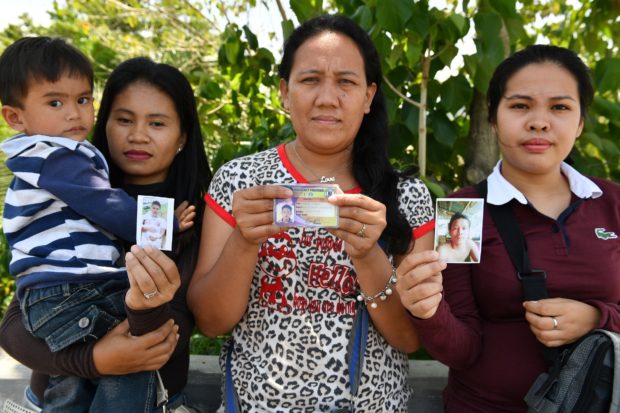
LOST IN SIEGE Alma Tome (left), Evelyn Powao and Melgie Powao show journalists photos of their husbands who remain missing a year after the Marawi siege. Another resident, Fatima Lumabao (not in photo) is looking for four of her eight children who disappeared when the fighting broke out. —AFP
(First of three parts)
MARAWI CITY — Fatima Lumabao has entertained thoughts of committing suicide in her fruitless search for her four missing children.
Lumabao said her children — Norhuda, 21; Rasida, 20; Parhana, 12; and Mohammad, 10 — went missing after Islamic State-allied gunmen laid siege to Marawi City on May 23 last year and started a five-month war that left more than a thousand people dead.
“What really happened to them? It seems I will never find them,” said the 48-year-old mother of eight.
If they were among the civilians killed, Lumabao said she wanted to find their remains.
“I’m already widowed. It pains me that they went missing and I have not gotten a single word on what happened to them,” she said. “[I want to find my children] so I could give them a decent burial, if indeed they died in the fighting.”
Lumabao was in Iligan City buying goods for her small variety store on the day the fighting between government forces and gunmen led by the Maute brothers and the bandit group Abu Sayyaf’s Isnilon Hapilon erupted.
She said Norhuda, who had a cell phone, managed to call her to say she and her siblings were leaving their house at Barangay Basak Malutlut in Marawi. Lumabao eventually lost contact with her daughter.
“When I was heading home, the vehicle I was in could not get through because fighting was going on. I was stranded for hours before we were finally allowed to pass,” Lumabao said.
She spent the night of May 23 at Barangay Bangolo. “The following day, I managed to walk to our house. Along the way, I saw bodies. Our house was a shambles. My children were not there,” she said.
Lumabao said she left when a Maute gunman told her to leave.
She went to the Lanao del Sur capitol compound in Marawi, where she found her four other children—Rakma, 19; Jamud, 17; Abdul Jamil, 15, and Alejana, 14.
Lumabao said she was hopeful that her four other children survived the fighting, although her village became one of the centers of the conflict.
A year after—nothing
But a year after the siege, none of her four children had shown up.
The military had confirmed that 47 civilians were killed, allegedly by Maute gunmen. Their remains had all been recovered, but none of the bodies belonged to any of Lumabao’s missing children.
As the people of Marawi struggle to rebuild their lives, Drieza Lininding, chair of the Moro Consensus Group, saw the need to take account of what they lost in the war.
But to this day, there has been no clear report or accounting of what happened in Marawi.
“They said more than 100,000 people were displaced. But the figures need validation. There are no clear, validated data we can consider official,” Lininding said.
He said one thing that needed to be resolved was the exact number of missing people.
Although the Management of the Dead and Missing (MDM) has buried more than 300 people in a Muslim cemetery and more than 70 families have requested DNA testing at the police office in Iligan City, there is no clear report yet on exactly how many people are missing and how many have been found.
When representatives of Human Rights Watch visited Marawi, Lininding learned that 3,000 people were trapped in the city’s buildings, including the provincial capitol.
“Those numbers were based on the distress calls made to their families,” he said.
“What the clearing operation did was recover remains that were found on the streets. What about those trapped inside destroyed buildings?” he asked.
The Armed Forces of the Philippines released a report showing that 1,780 civilians were rescued and more than 900 Maute gunmen were killed in the fighting, but the figures could not be independently verified.
Military records also showed that 168 soldiers and policemen died in battle.
The International Committee of the Red Cross (ICRC), which put up a tracing site, said it had received more than 400 requests to find missing relatives since the fighting started.
“The humanitarian issue of ‘missing persons’ is often overlooked in postemergency situations. The issue of missing people may not be perceived as urgent as the need for food, water or shelter, but it has serious and lingering consequences for families who are still looking for their loved ones, and ultimately on the community as a whole,” said Camilla Matteucci, head of the ICRC Protection team in the Philippines.
No investigation
Zia Alonto Adiong, spokesperson for the Lanao del Sur crisis management committee, said the group did not know what happened to the missing.
The MDM, which is under the supervision of the Department of the Interior and Local Government , had stopped giving it reports, Adiong said.
It has been a year after the siege but neither the Senate nor the House of Representatives had launched an inquiry, Lininding said.
“All of them are silent,” he said. “There has to be a congressional inquiry, not only for the Maranao but [also] for the families of those who were killed there—the civilians, soldiers and policemen. Their families deserve [to know] the truth.” —With reports from Riche Umel and Jeoffrey Maitem